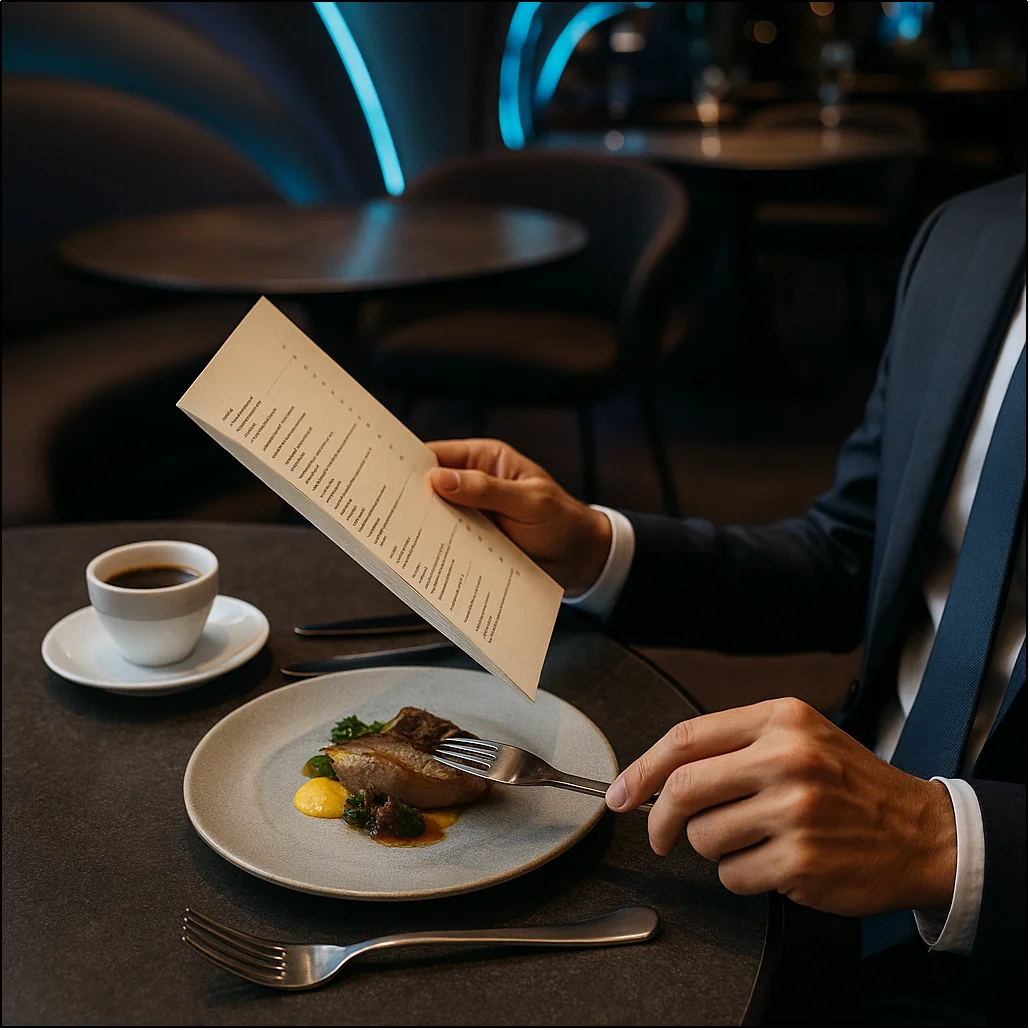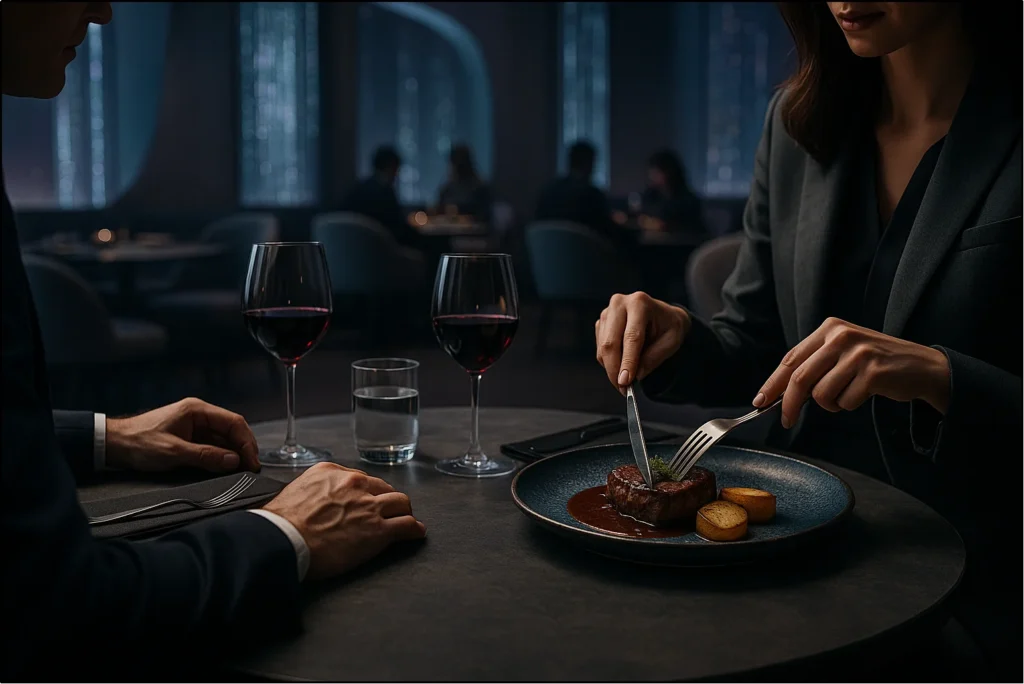Sharing a meal in a professional setting can feel like more than just eating together. For many, the table becomes a stage where first impressions are made, relationships are strengthened, and opportunities are won or lost.
That is why understanding proper dining etiquette is essential. It is not just about using the right fork. It is about showing respect, confidence, and professionalism in every small action. Whether you are attending a private dining in Dubai or hosting an important client dinner, the way you handle yourself at the table speaks volumes.This guide will walk you through key practices that will help you navigate any business meal with ease and confidence. Keep reading to learn the essentials that will make every professional dining experience seamless and impactful.
Arrive and Prepare in Advance
Punctuality sets the tone for any business meal. Arriving a few minutes early shows respect for your host and the occasion. It also allows you to settle in, observe the environment, and prepare for the meeting without feeling rushed.
Dress Appropriately
Your appearance sends a message before you even sit down. For a business meal, choose professional attire that complements the venue’s atmosphere. Conservative choices often work best, as they avoid drawing attention away from the conversation.
The goal is to project confidence and respect while ensuring your clothing is suitable for the setting.
Review the Menu
Looking at the menu in advance allows you to make decisions quickly and avoid dishes that might be difficult to manage. This shows that you are prepared and considerate of the group’s time.
Selecting a simple, tidy meal also helps maintain proper dining table etiquette throughout the meeting.
Stay Calm and Collected
Arriving early gives you a moment to compose yourself and shift into a professional mindset. Use this time to silence your phone, gather your thoughts, and focus on the purpose of the meeting.
A calm, collected presence is often noticed long before the first course arrives and sets a positive tone for the entire meal.
Napkin Etiquette: How to Properly Use Your Napkin
The napkin is one of the first signals of proper dining etiquette at the table. Handling it correctly sets the tone for the rest of the meal and shows awareness of fine dining etiquette standards.
How to Unfold Your Napkin Gracefully
When you are seated and the host has placed their napkin, pick up yours and unfold it carefully. Avoid shaking it open. Place it neatly across your lap to keep your clothing protected and maintain a polished appearance.
Where to Place Your Napkin During the Meal
Keep the napkin fully on your lap throughout the meal. If you need to leave the table temporarily, place it on your chair to signal you are returning. This small action reflects an understanding of dining etiquette that professionals often notice.
The Right Way to Signal You’re Done with Your Meal
When you are finished, fold the napkin loosely and set it to the left of your plate. This quiet signal tells the staff you are done without needing to speak, a detail often observed in both casual and fine dining etiquette.
Understanding When to Start and Pause During the Meal
Timing is a key part of dining etiquette during business meals. Starting too soon or pausing at the wrong moment can send unintended signals to others at the table.
Wait for the Host
Always allow the host or the most senior person at the table to begin eating first. This shows respect for their role and sets a unified pace for the meal. In business settings, this simple act often leaves a positive impression on colleagues and clients.
Don’t Start Until Everyone Is Served
Hold off on eating until all plates are on the table. This small but important step demonstrates patience and awareness of dining table etiquette. It also creates a sense of shared experience, which is vital in building professional relationships.
Pausing Gracefully
If you need to pause during the meal, place your utensils on your plate at a slight angle or cross pattern. This nonverbal cue signals to the staff that you are not finished while maintaining proper dining etiquette.
Utensil Etiquette: Silent Signals and Proper Use
Mastering how to handle utensils shows confidence and awareness of proper dining etiquette. Subtle cues with cutlery also help you communicate with the staff without speaking.
American and European Styles
In American dining table etiquette, you cut food with the knife in your right hand and then switch the fork to that hand to eat. In the European style, you keep the fork in your left hand and the knife in your right throughout the meal.
Either style is acceptable as long as you are consistent and use them neatly.
Silent Signals with Utensils
When you are finished with a course, place your knife and fork parallel at the 4 o’clock position on the plate. This signals to the server that you are done without needing to say anything. Keeping the utensils crossed in the center indicates you are still eating.
These small details are a mark of fine dining etiquette.
Handling Cutlery with Care
Hold utensils lightly and avoid scraping them against the plate. Gentle, quiet movements not only reflect good manners but also make the dining experience pleasant for everyone at the table.

Dining Etiquette: Phone Etiquette and Posture Tips
Your behavior at the table speaks as much as your words. Good posture and mindful phone use are essential parts of modern dining etiquette in business settings.
Keep the Phone Silent or Off
A ringing or buzzing phone disrupts the flow of a meal. Turn it off or keep it on silent mode before sitting down. Avoid placing it on the table, as it can signal distraction.
In business meals, giving full attention to the people present reflects respect and professionalism.
Maintain Upright Posture
Sit comfortably with your back straight and both feet on the floor. Leaning back or slouching can appear careless, while leaning too far forward may seem intrusive. Balanced posture helps you project confidence and attentiveness during conversations.
Keep Elbows Off the Table
Keep elbows away from the table while eating, especially in formal settings. Resting forearms lightly on the edge between courses is acceptable, but keeping elbows off maintains traditional dining etiquette and a polished appearance.
How to Order Food and Alcohol Professionally in Dubai
The way you order food and handle drinks during a business meal can affect the impression you leave. Good choices show awareness of dining table etiquette and cultural respect.
Follow the Host’s Lead
Allow the host to guide the ordering process. If they suggest certain dishes or courses, follow their cues. This shows deference to their role and keeps the meal flowing smoothly.
Choose Simple Dishes
Opt for meals that are easy to eat and avoid anything messy or overly complicated. Selecting simple dishes helps you stay focused on the conversation without worrying about handling the food.
Limit Alcohol
If alcohol is served, keep consumption minimal. In Dubai, be mindful of local norms and the setting of the restaurant. Maintaining control at the table reflects professionalism and aligns with fine dining etiquette in business environments.
How to Navigate Conversation and Toasting Etiquette
The dialogue at the table carries as much weight as the food itself. Balanced conversation and proper toasting etiquette can strengthen professional relationships during a business meal.
Keep Topics Professional and Pleasant
Avoid subjects that may make others uncomfortable, such as politics or sensitive personal matters. Light, engaging topics help create a relaxed environment. Asking thoughtful questions shows interest in the other person and maintains good dining etiquette throughout the meal.
Maintain Eye Contact
When speaking or listening, make steady but natural eye contact. It conveys respect and attentiveness, both of which are essential in professional dining settings.
Toasting with Care
If a toast is offered, participate respectfully. Raise your glass slightly, make brief eye contact, and take a small sip. In Dubai, keep toasts short and appropriate to the occasion, aligning with the tone of the business meal and fine dining etiquette standards.
How to Finish a Business Meal with Grace
How you end a business meal can leave as strong an impression as the start. Proper closing gestures show polish and attention to detail.
Match the Pace of the Table
Try to finish at a similar pace to others, especially the host. Eating too quickly or too slowly can disrupt the flow of the meal. Aligning your timing reflects good dining table etiquette and consideration for the group.
Thank the Host
When the meal ends, thank the host sincerely for their time and hospitality. A short follow-up message later reinforces professionalism and respect.
Napkin and Utensil Placement
Place your utensils together at the 4 o’clock position on the plate to signal you are finished. Fold your napkin loosely and set it to the left of the plate. These quiet gestures reflect an understanding of fine dining etiquette and attention to subtle details.
Cultural Etiquette: Dining Etiquette in Dubai
Respecting local customs is essential when dining in Dubai. Awareness of cultural practices shows sensitivity and enhances your professionalism during business meals.
Use the Right Hand
When eating or passing food, always use your right hand. In local tradition, the left hand is considered impolite for handling food. This small adjustment reflects respect for cultural norms and aligns with proper dining etiquette.
Offering and Receiving Coffee
Arabic coffee is a sign of hospitality. When offered, accept with your right hand and take a small sip. Gently shake the cup side to side to signal you are finished. These small gestures demonstrate cultural awareness at the dining table.
Respect Dietary Practices
Be mindful of local dietary rules, such as avoiding pork, and understanding alcohol restrictions in certain venues. Choosing dishes with care shows cultural sensitivity and supports professional fine dining etiquette in Dubai.
Final Thoughts
Mastering dining etiquette for business meals is more than following rules at the table. It is about presenting yourself with confidence, respect, and cultural awareness. Every gesture, from how you place your napkin to the pace of your conversation, contributes to the impression you leave behind. Practicing these skills allows you to focus on the relationships that matter while ensuring the meal flows smoothly.
If you are planning a professional meeting or business lunch, Woohoo offers an ideal setting with a balance of comfort and refinement.
Frequently Asked Questions
What should I do if I accidentally use the wrong utensil at a formal dinner?
If you pick up the wrong utensil, continue using it calmly without drawing attention to the mistake. Switching midway can create more disruption. In fine dining etiquette, confidence and composure matter more than perfection. Observing others at the table can also guide you through the rest of the courses without further errors.
How do I handle dietary restrictions during a business meal?
If you have dietary needs, inform the restaurant when making the reservation. Quietly select appropriate dishes without making the restriction the center of conversation. This approach maintains professionalism and keeps the focus on the meeting. Being discreet also shows respect for both dining table etiquette and your host’s planning.
Is it acceptable to take leftovers home from a business lunch?
In formal or business dining settings, taking leftovers is generally discouraged unless the host suggests it. The meal is meant to facilitate conversation, not focus on the food itself. If offered, accept politely. Otherwise, leaving the table as it is aligns with standard dining etiquette in professional environments.
How can I gracefully decline alcohol if it is offered?
Simply place your hand gently over your glass or say, “No, thank you,” with a smile. In Dubai, many venues respect personal or cultural reasons for declining. A polite refusal is widely accepted and does not break fine dining etiquette. Maintaining composure ensures the moment passes smoothly without interrupting the flow of the meal.
What is the best way to excuse yourself during the meal?
Wait for a natural pause in conversation, place your napkin on your chair, and excuse yourself briefly. Avoid leaving during key courses, such as the main dish, unless necessary. This small action aligns with dining etiquette for kids and adults alike, showing courtesy to the host and other guests.
In formal or business dining settings, taking leftovers is generally discouraged unless the host suggests it. The meal is meant to facilitate conversation, not focus on the food itself. If offered, accept politely. Otherwise, leaving the table as it is aligns with standard dining etiquette in professional environments.
Simply place your hand gently over your glass or say, “No, thank you,” with a smile. In Dubai, many venues respect personal or cultural reasons for declining. A polite refusal is widely accepted and does not break fine dining etiquette. Maintaining composure ensures the moment passes smoothly without interrupting the flow of the meal.
Wait for a natural pause in conversation, place your napkin on your chair, and excuse yourself briefly. Avoid leaving during key courses, such as the main dish, unless necessary. This small action aligns with dining etiquette for kids and adults alike, showing courtesy to the host and other guests.





